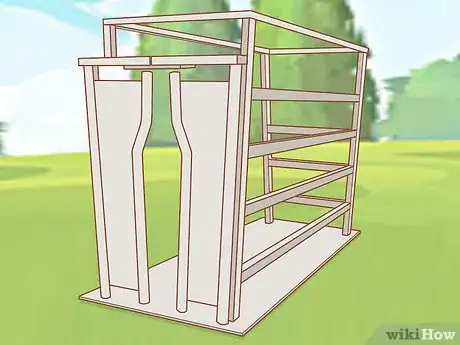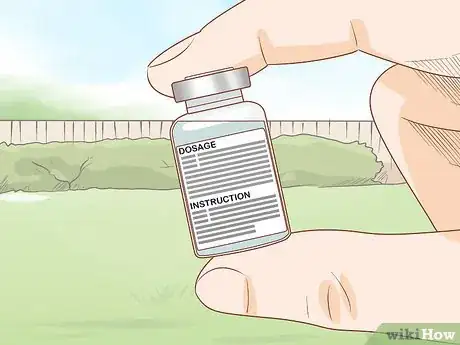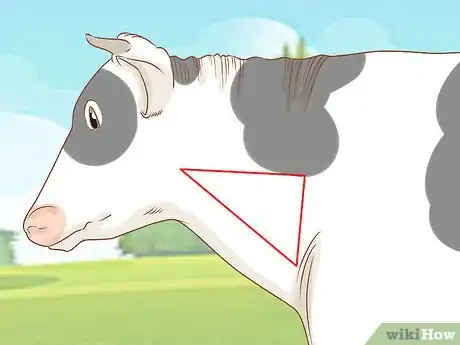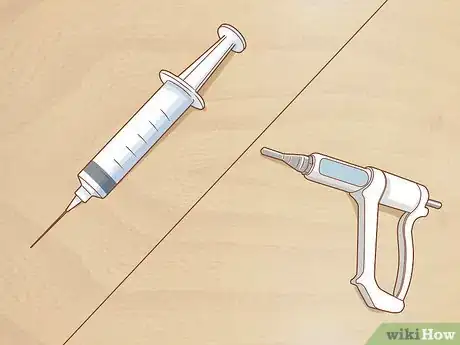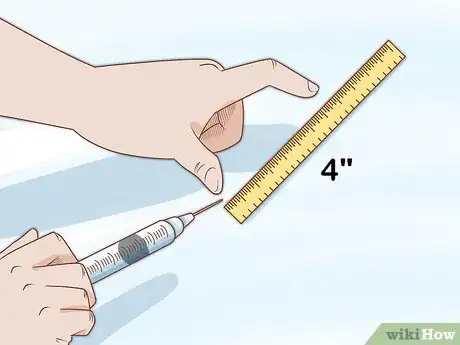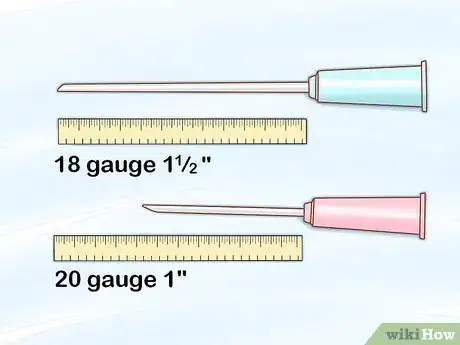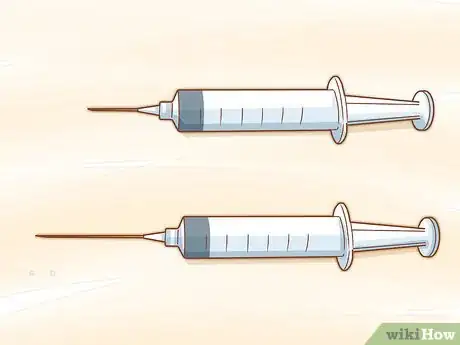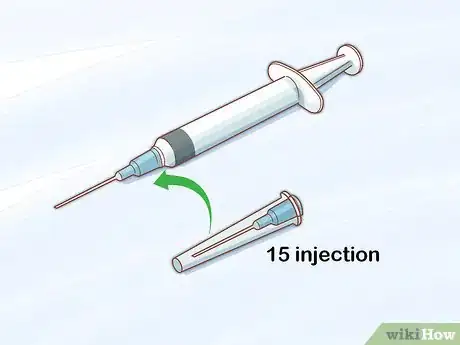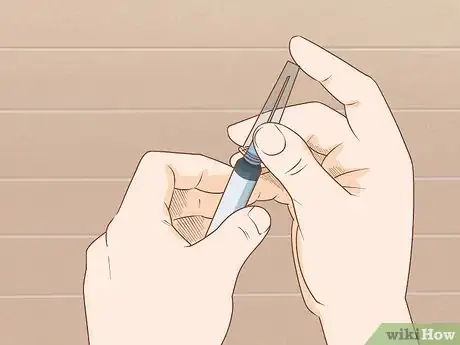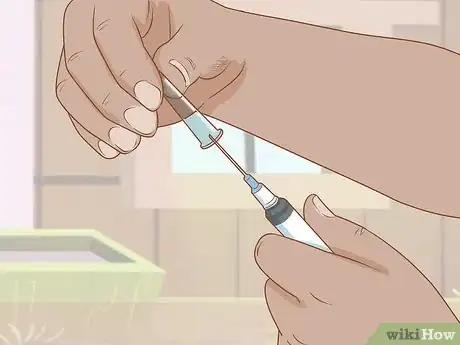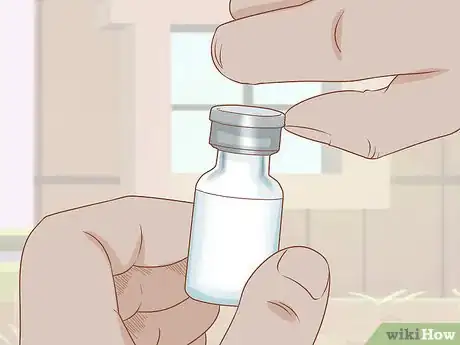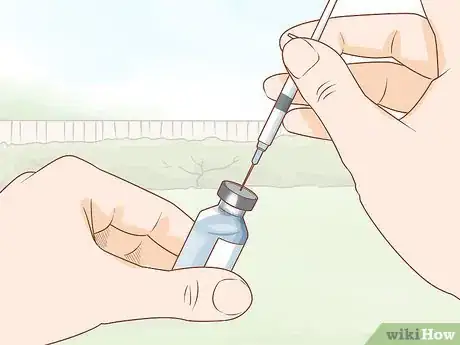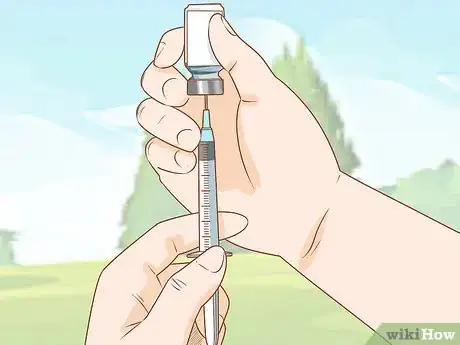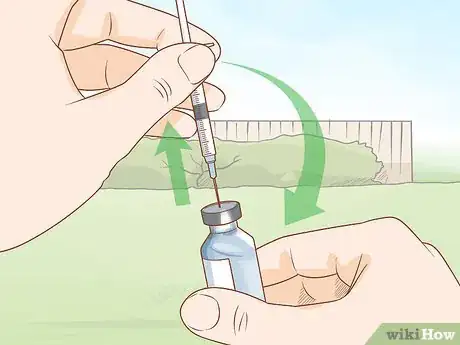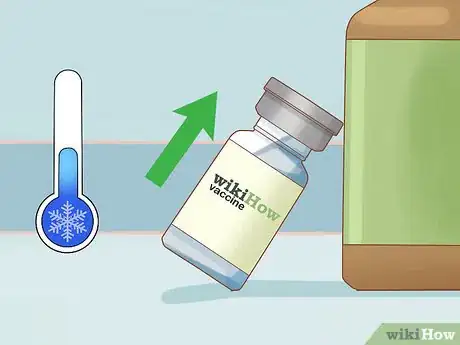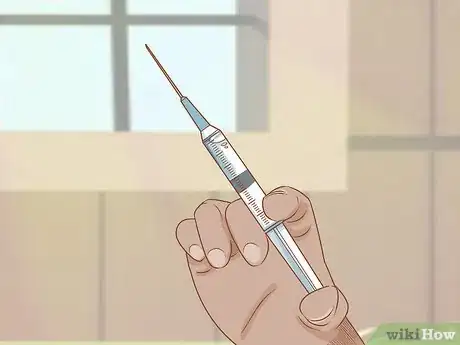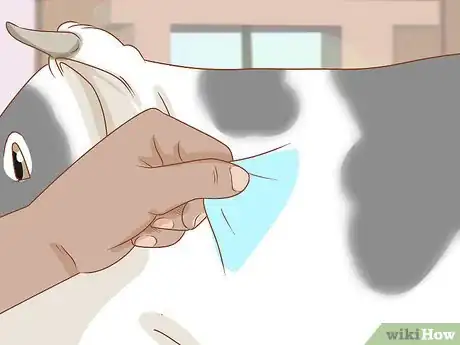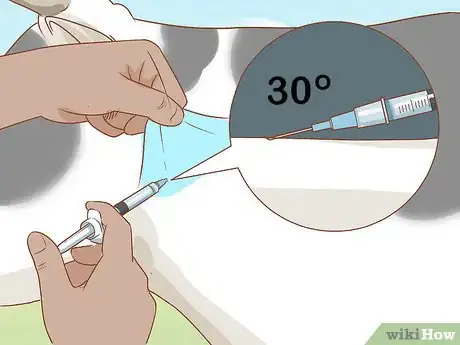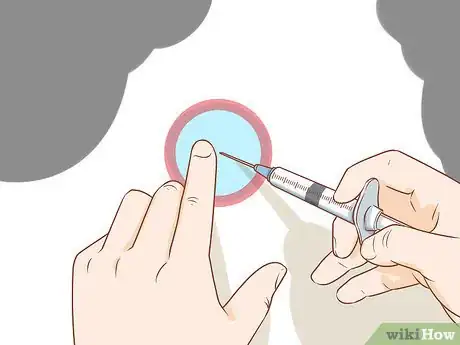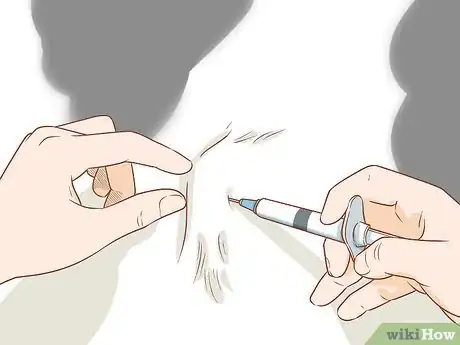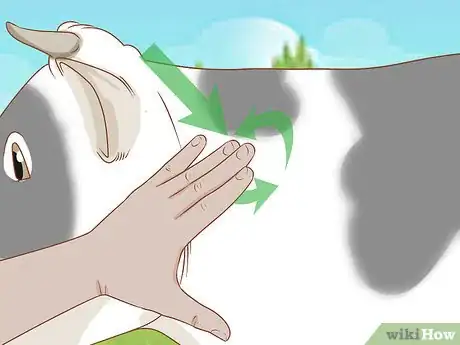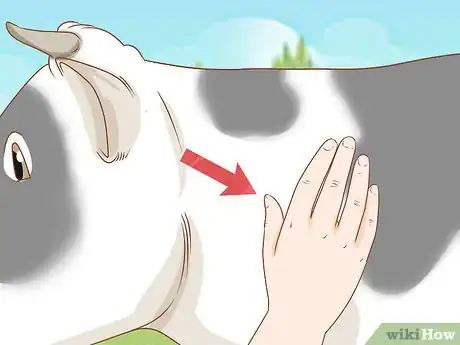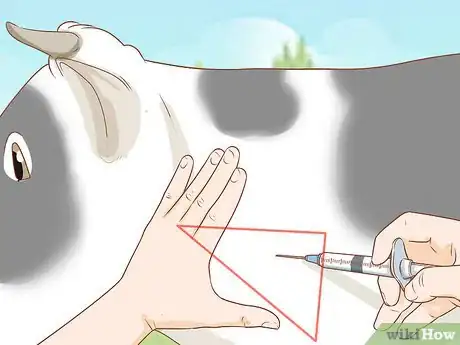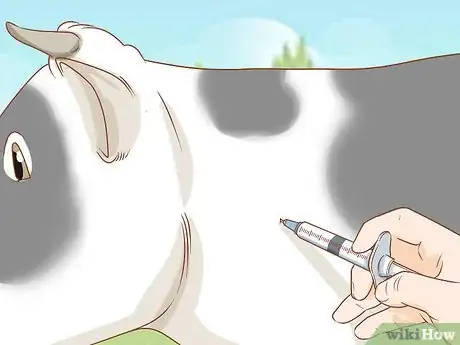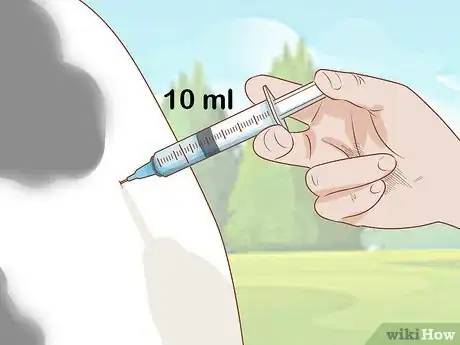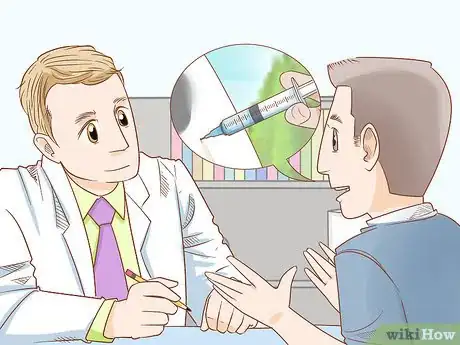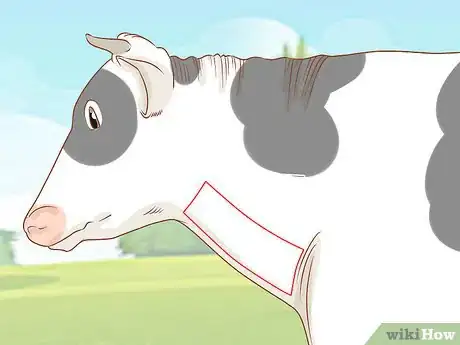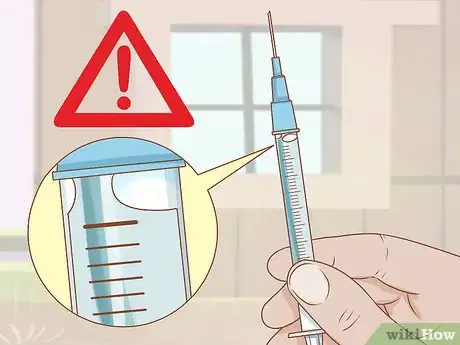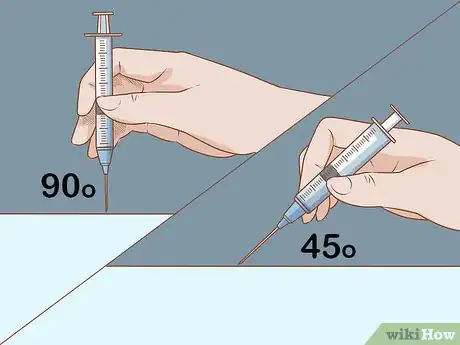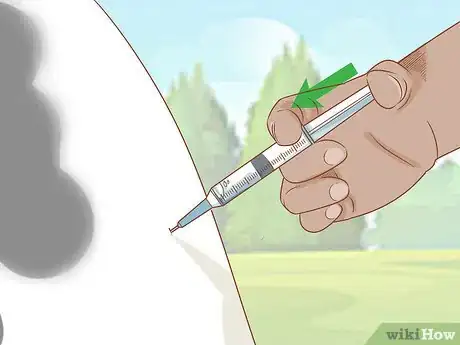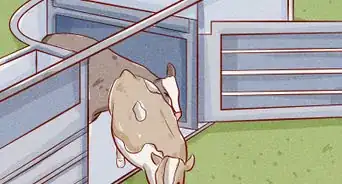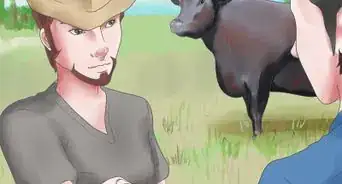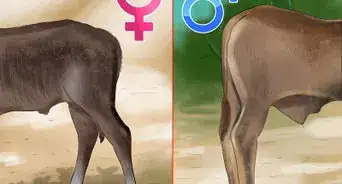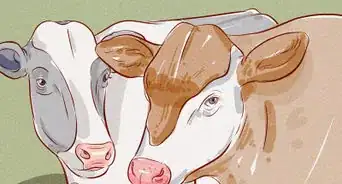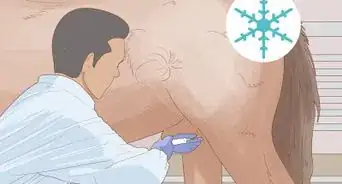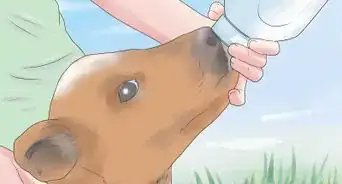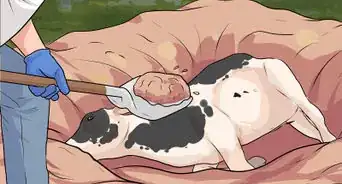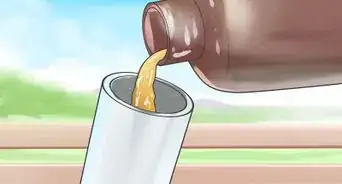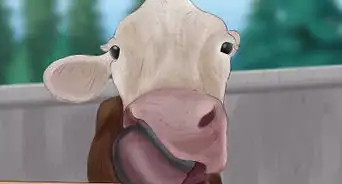This article was co-authored by wikiHow Staff. Our trained team of editors and researchers validate articles for accuracy and comprehensiveness. wikiHow's Content Management Team carefully monitors the work from our editorial staff to ensure that each article is backed by trusted research and meets our high quality standards.
There are 9 references cited in this article, which can be found at the bottom of the page.
wikiHow marks an article as reader-approved once it receives enough positive feedback. In this case, 89% of readers who voted found the article helpful, earning it our reader-approved status.
This article has been viewed 326,663 times.
Learn more...
Knowledge of how to give cattle injections or shots sub-subcutaneously (SQ; under the skin), intramuscularly (IM; directly into the blood supply of the muscle), or intravenously (IV; directly into the vein, usually the jugular vein), is necessary to treat cattle with vaccines and other medicines. See your veterinarian for medicines and vaccinations for your cattle, and instruction on properly giving your animals an injection. Seek veterinary help if an intravenous injection is required as this is much more difficult than SQ or IM injections.
Steps
Preparing for the Injection
-
1Restrain the cow before giving the injection. It is much easier and safer to give injections to cattle that are restrained. You can use a head gate or squeeze chute (also called a crush) to restrain the cow. No matter what method of restraint you use, make sure that the cow is restrained well enough that it will not be able to injure you or someone else.[1]
- A squeeze chute or cattle crush is a narrow stall with adjustable sides wide enough for 1 adult cow. The panels prevent the animal from moving. It may also have a calming effect on the animal. There’s also a gate in the front and back of the chute to keep the cow still. This makes the neck easily accessible for injections.
-
2Read the label. Always read and follow the directions on the label of the medication or vaccination for the dosage and route of administration. The drug manufacturer is obliged by law to print instructions on the injection bottle as well as warnings, information about the targeted microorganisms, and other important details.[2]
- If there is an option to choose between an intramuscular (IM) and subcutaneous (SQ) injection route, always go for the SQ as it is less invasive, which means it is less likely to damage valuable carcass meat.[3] However, some drugs need to be given by IM injection to be properly absorbed.
Advertisement -
3Find the injection site. The required site for injection, particularly in beef cattle, is a site called the "injection triangle." This triangular area is located on either side of the cow’s neck and contains few vital structures (like blood vessels and nerves). The injection triangle is broadest at the shoulder and tapers up towards the ear. The retail value of meat from this site is lower than the rump, so you are less likely to lose money if you are planning on selling the meat.[4] The landmarks for finding the triangle are:[5]
- The upper boundary is located below the spinal column following the line of the neck crest.
- The lower or angular boundary runs along and above the jugular furrow, which is located in the middle of the neck.
- The posterior boundary (the one closest to the rear of the animal) follows the line above the point of the shoulder, which angles up towards the top-line or top of the shoulder.
-
4Select the syringe or dosing gun. The difference between the 2 is that with a syringe, you manually control how much of the drug gets injected into the cow. The dosing gun dispenses pre-set volumes of medicine for administering them to more than 1 animal.
- A syringe is made up of 3 parts: the body (that contains the drug), the plunger (that fits snugly inside the barrel), and the needle. Syringes are plastic and you use them no more than once or twice before they need to be thrown away. Plastic syringes come in 1, 2, 3, 5, 12, 20, 35, and 60 cc (1 cc = 1 mL) sizes. Use the syringe size required for the dose you are giving. A dose in a syringe should only be used for 1 animal.
- A dosing gun or pistol syringe has a glass barrel (loaded with multiple doses) with a plunger that has a thick rubber washer at the end to form a vacuum, a needle, and a handle-trigger that is the same as that on a caulking gun. Some guns have the option of attaching a bottle. Dosing guns come in 5, 12.5, 20, 25, and 50 mL sizes.
-
5Vary the injection sites. This is if you have more than one medication or vaccination to give. The next shot should be administered in a place that is at least 4 inches (10 cm) (about a palm’s width) away from the first shot site.[6]
- If you keep putting medication into the same spot, the cow’s body will have a harder time absorbing it. The medications could also react and become ineffective, or they could cause an adverse reaction that may kill the animal.
Selecting the Needle
-
1Choose a needle based on the animal's weight. Needle size is measured in ‘gauges’. The gauge of a needle is inversely proportional to its diameter, so the lower the gauge, the bigger the needle. For instance, a calf's skin is thinner than that of an adult cow, so a finer and higher gauge needle can be used instead. Use the finest gauge possible to make sure that the cow feels as little pain as possible, but not so fine that risk of breaking the needle is significant.[7]
- To give an injection to a calf weighing less than 500 pounds, an 18-20 gauge (g) needle with a 1 inch (2.5 cm) length is ideal.
- For larger animals weighing over 500 pounds, you will need a 16-18 g needle with of 1 ½ inch length.
- Breed can also play a part on determining needle gauge. Black Angus cattle tend to have thinner hides than Herefords, for instance, so you won't need a 16 g needle to pierce the thinner hide of an Angus cow, versus the thicker one of a Hereford.
-
2Choose needle length based on the type of injection. You will need a shorter needle for subcutaneous injections, and a longer needle for intramuscular and intravenous injections.[8]
- You won't need a needle longer than 1⁄2 inch (1.3 cm) to 1 inch (2.5 cm), for SQ injections because you only need to penetrate the skin.
- For IM and IV injections, needles that are around 1.5 inch (3.8 cm) or more are best.
-
3Use a new, sterile needle for every 10 to 15 injections. It is acceptable to use the same needle for up to 15 injections as long as it remains sharp and straight. Always change to a new needle when drawing from a different bottle of medication because using the old needle may introduce contamination.[9]
- Never attempt to straighten a bent or burred needle because it is much more likely to break on you or break off in the process of injection. Burred needles are also to never be straightened, but simply tossed into a bio-hazard bin.
Drawing Medication into the Syringe
-
1Take a syringe and cap it with a needle. The needle will have a cap on it when you push it onto the end of the syringe, or should if it's a fresh, clean needle. Push the needle down on the syringe so the needle stays on and won't come off.
-
2Remove the needle cap. Take the cap off the needle and have it ready to draw fluid into the syringe. You won't be able to get medication into the syringe if you have the cap still placed over the needle.
-
3Take a new bottle and remove the aluminum cap. The aluminum cap protects the opening of the bottle and keeps the liquid from leaking out, such as if the bottle is tipped on its side or upside down. Use your fingernails to remove the cap. Never use a knife or sharp object because you will compromise the rubber cap and invite contamination.
-
4Poke the needle through the rubber cap. Before you do so, draw the same amount of air into the syringe as you want to draw from the bottle.[10] This makes it easier for you to draw in the contents. Then, you can poke the needle into the rubber cap.
- The rubber cap will act as a vacuum to keep air out of the bottle, and when the needle is pushed through, this vacuum will not be disrupted.
-
5Draw the medication into the syringe. After you have pushed the air in your syringe into the bottle, raise the bottle up so that it is almost vertical above the syringe, and slowly pull back on the plunger. Draw the fluid into the syringe up to the desired amount.[11]
- It's important to raise the bottle above the syringe to allow gravity to draw the fluid in, and so that you're not drawing in air instead.
-
6Lower the bottle and slowly remove the needle. Lowering the bottle moves the liquid to the bottom (via gravity) and introduces the "air" component of the bottle. Removing the needle then ensures that liquid won't drip out.
-
7Place the bottle upright in a safe place for future use. Store the bottle in a place where it's cool and dry and won't get damaged, like in a cooler or toolbox meant for storing your cattle medicating equipment.
-
8Point the needle upwards to allow any air bubbles present to float to the top. Flick your finger against the barrel for any bubbles that don't automatically float up. Slowly and carefully push the plunger to eject the air bubbles.[12]
- This especially important if you are going to administer IM or IV injections.
Giving a Subcutaneous (SQ) Injection
-
1Use the "tenting" technique. If you are right-handed, hold the syringe in your right hand (and vice versa if you are left-handed). Identify the injection triangle and choose a spot in the center of this imaginary triangle. Using your left hand, pinch some of the animal's skin between your 2 forefingers and thumb. Lift this piece of skin straight out and away from the neck to form a "tent."[13]
-
2Angle the needle so that it is at a 30 to 45 degree angle from the surface of the neck. The tip of the needle can be placed under your thumb. Where you place the tip of the needle depends on what you are most comfortable with and where you are least likely to poke yourself.[14]
- Take care not to touch the plunger (if using a syringe) or trigger (if using a dosing device).
-
3Guide the needle into the injection site. Using the forefinger of the hand holding the syringe, guide the needle into the center of 1 side the tent. This ensures you only insert the needle halfway instead of all the way into the skin fold, and reduces the chance of hitting muscle or a blood vessel.
-
4Administer the shot. Once the needle is in at the required depth, release the skin and depress the plunger or squeeze the handle of the syringe with your syringe hand. Apply slow, steady pressure to the plunger. Once the injection is complete, withdraw the needle, cap it, and place the syringe on a dry, clean surface for future use, such as if you are planning on giving injections to more than 1 animal.
-
5Reduce any bleeding that may occur. Press and rub the injection site with your hand for a few seconds so that the spot does not bleed too much and to insure the injected fluid does not leak out too much. An SQ injection should not bleed nearly as much as an IM or IV injection, if at all, but there is greater risk of injected fluid leaking out. This leakage might be profuse if the skin is really tight or too much fluid is injected into 1 site.
Giving an Intramuscular (IM) Injection
-
1Reduce the painful feeling of the needle plunging in. Because intramuscular injections are more painful than a SQ injection, efforts must be made to reduce the pain that a cow will feel when the needle is put in. To lessen the pain then, most veterinarians firmly thump the heel of their hand against the cow’s neck two or three times prior to introducing the needle. It's highly recommended you follow this procedure.[15]
- Thumping the cow’s neck with your hand desensitizes the nerves so when the needle goes in, the cow is less likely to feel the needle going in and become startled.
-
2Select a location to administer the IM injection. Hold the syringe in your dominant hand (right, if right-handed). Identify the injection triangle and select an area near the center. Then, get ready to put the needle in at a perpendicular angle to the surface of the skin.[16]
-
3Put the needle into the cow’s neck. Keeping the needle perpendicular to the skin surface and a using firm, thrusting movement, push the needle through the skin into the muscle. This must be done immediately after the neck has been thumped a few times. The cow may flinch at this point, so be ready for it to move around a little in the chute, or a bit more if it's not used to human contact.
- Check to see if you have hit a vein or artery. To do this, withdraw the plunger of the syringe a small amount and look for blood back-flow. If you find blood going into the syringe, you’ve hit a blood vessel. You will have to withdraw and try a different site about 1 in (2.5 cm) from this site.[17]
-
4Administer the medicine. Once you have checked that you have not hit a blood vessel, you can administer the medication. Slowly depress the plunger until the cow has received the correct dose. If you are giving more than 10 milliliters (0.34 fl oz) IM, be sure to give no more than 10 milliliters (0.34 fl oz) per injection site.[18]
- After you have removed the syringe, press the spot with your fingers for a few moments to keep the spot from bleeding.
Giving an Intravenous (IV) Injection
-
1Seek veterinary assistance to perform an IV injection.[19] Giving an IV injection takes a lot of skill and practice. It is a specialized technique not often administered to cattle by the owner. If you cannot perform the IV injection properly or don't know exactly how it's done, contact your veterinarian and have them perform the procedure for you.
-
2Locate the jugular vein. You can do this by running your fingers down the side of the cow's neck (it will be below where the invisible injection triangle would be) above the dewlap. You will feel the jugular vein throbbing. Once you have located it, press down on the lower part of the vein to make it bulge out. This will help you better locate the vein when giving the shot.[20]
-
3Check to make sure that there are no bubbles in your syringe. Air bubbles, if injected into the jugular vein, can cause a serious health risk, if not death. If air is present in the syringe where the medication has been injected, hold the syringe upright and tap it using your fingers, until the air bubbles go up.[21] Disperse the bubbles further by slightly depressing the plunger until all the air bubbles have noticeably gone out. A little medication will come out of the needle as you do so.
-
4Insert the syringe at a 30 to 45 degree angle to the surface of the neck. Slowly, but firmly, insert the syringe into the bulging jugular vein. You will know if you have correctly hit the jugular vein because just a slight pulling of the plunger will draw blood into the syringe and mix with its contents. This is a good sign, unlike for SQ and IM injections.
-
5Administer the medicine. Very slowly press down on the plunger so that the fluid gradually goes into the cow’s vein. Once you have given the required amount of medicine, gently remove the needle. Hold your hand over the spot and press against it for a few moments to reduce the bleeding that will occur when you give this type of shot.
Community Q&A
-
QuestionHow do I give a tetanus shot to a calf?
 Community AnswerTetanus shots are usually given under the skin. The vaccine's package should have instructions that you can go over with your vet.
Community AnswerTetanus shots are usually given under the skin. The vaccine's package should have instructions that you can go over with your vet. -
QuestionDuring an IM injection, mostly blood come out. What's the problem? My injection site is in the triangle.
 KarinTop AnswererIt's obvious that you did an IV injection, rather than an IM. With an IM, very little to no blood should come into the syringe. You need to hit the muscle tissue of the neck, not the jugular vein/carotid artery.
KarinTop AnswererIt's obvious that you did an IV injection, rather than an IM. With an IM, very little to no blood should come into the syringe. You need to hit the muscle tissue of the neck, not the jugular vein/carotid artery. -
QuestionWhat type of injection do I use for antibiotics for a dairy cow?
 KarinTop AnswererMost antibiotics will recommend using a sub-cutaneous (SubQ) injection technique. Please check the label of the drug before using just to make sure, because some may recommend intra-muscular (IM) over SubQ. Also check the recommendations for dairy cows, as not all antibiotics are suitable for cows that are lactating milk intended for human food consumption.
KarinTop AnswererMost antibiotics will recommend using a sub-cutaneous (SubQ) injection technique. Please check the label of the drug before using just to make sure, because some may recommend intra-muscular (IM) over SubQ. Also check the recommendations for dairy cows, as not all antibiotics are suitable for cows that are lactating milk intended for human food consumption.
Warnings
- Don't get in the race or working alley with cattle unless you want to be squashed. Always work the cattle from the outside of the race, never inside.⧼thumbs_response⧽
- Avoid putting your head inside the gates of the chute or crush as this may result in serious to fatal injuries to you.⧼thumbs_response⧽
Things You'll Need
- Needles (clean and disinfected)
- Syringes (of the proper size)
- Vaccine or medicine
- Head-gate and crush (or squeeze chute) with handling facility attached
- Cattle that need to be treated or vaccinated
References
- ↑ https://digitalcommons.unl.edu/cgi/viewcontent.cgi?referer=&httpsredir=1&article=1352&context=extensionhist
- ↑ https://digitalcommons.unl.edu/cgi/viewcontent.cgi?referer=&httpsredir=1&article=1352&context=extensionhist
- ↑ http://digitalcommons.unl.edu/cgi/viewcontent.cgi?article=1352&context=extensionhist
- ↑ http://www.cals.arizona.edu/ans/bqa/PDF/BQA_Book.pdf
- ↑ http://msue.anr.msu.edu/news/beef_quality_assurance_certification_training_available
- ↑ https://acbs.cals.arizona.edu/bqa/PDF/BQA_Book.pdf
- ↑ https://digitalcommons.unl.edu/cgi/viewcontent.cgi?referer=&httpsredir=1&article=1352&context=extensionhist
- ↑ http://digitalcommons.unl.edu/cgi/viewcontent.cgi?article=1352&context=extensionhist
- ↑ https://acbs.cals.arizona.edu/bqa/PDF/BQA_Book.pdf
- ↑ http://www.omafra.gov.on.ca/english/livestock/vet/facts/07-031.htm#general
- ↑ http://www.omafra.gov.on.ca/english/livestock/vet/facts/07-031.htm#general
- ↑ http://www.omafra.gov.on.ca/english/livestock/vet/facts/07-031.htm#general
- ↑ http://www.omafra.gov.on.ca/english/livestock/vet/facts/07-031.htm#injection
- ↑ http://digitalcommons.unl.edu/cgi/viewcontent.cgi?article=1352&context=extensionhist
- ↑ http://digitalcommons.unl.edu/cgi/viewcontent.cgi?article=1352&context=extensionhist
- ↑ http://digitalcommons.unl.edu/cgi/viewcontent.cgi?article=1352&context=extensionhist
- ↑ http://www.omafra.gov.on.ca/english/livestock/vet/facts/07-031.htm#general
- ↑ https://acbs.cals.arizona.edu/bqa/PDF/BQA_Book.pdf
- ↑ http://www.omafra.gov.on.ca/english/livestock/vet/facts/07-031.htm#general
- ↑ http://digitalcommons.unl.edu/cgi/viewcontent.cgi?article=1352&context=extensionhist
- ↑ http://www.omafra.gov.on.ca/english/livestock/vet/facts/07-031.htm#general
About This Article
Giving your cattle injections can seem like a chore, but by choosing the right injection site and needle size, the process will go a lot smoother. Before you begin, make sure you restrain your cattle using a head gate or squeeze chute so they don’t injure you or themselves. The best place to inject cattle is in their lower neck, since there are few blood vessels and nerves there. If you’re giving your cattle multiple injections, choose a new site that’s at least 4 inches away from the first to help its body absorb the medication. For calves and cattle under 500 pounds, use an 18 to 20-gauge needle. For cattle over 500 pounds, use a 16 to 18-gauge needle. Once you’ve filled the syringe with the medication, point the needle upwards and flick the barrel to get rid of any air bubbles. For more tips, including how to do a subcutaneous cattle injection, read on.
